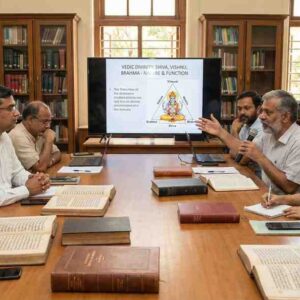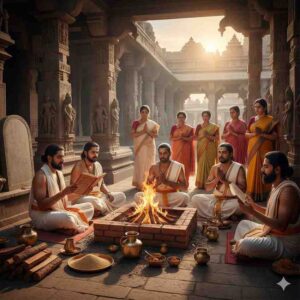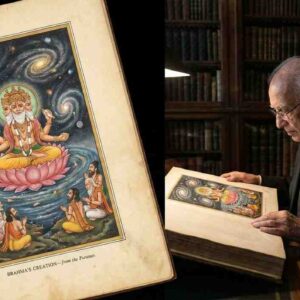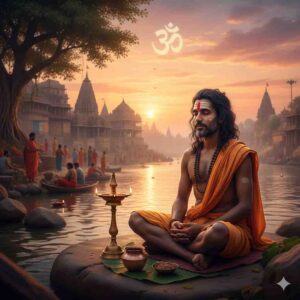TheVedas, revered as the oldest spiritual scriptures in Hinduism, are often classified asreligious texts, providing rituals, hymns, and prayers that guide devotees in their spiritual practices. However, a closer examination reveals that the Vedas are far more than a manual for religious ceremonies—they are a profound reservoir ofphilosophical wisdom. These ancient texts address questions of existence, consciousness, and the universe, offering insights that transcend ritualistic boundaries.
This article explores whether the Vedas are merely religious texts or if their philosophical depth positions them as foundational works of human inquiry.
The Religious Dimension of the Vedas
The Vedas, regarded asShruti(divinely revealed knowledge), provide the framework for Hindu rituals and practices.
Key Religious Features of the Vedas
- Hymns to Deities: The Rigveda includes hymns dedicated to deities like Agni (fire) and Indra (rain), symbolizing humanity’s connection to natural and divine forces.
- Sacrificial Rituals: The Yajurveda outlines rituals such as yajnas (fire sacrifices), ensuring harmony between the human and cosmic realms.
- Chants and Prayers: The Samaveda emphasizes chanting and music as tools for devotion and spiritual alignment.
- Practical Guidance: The Atharvaveda includes mantras and spells for daily life, reflecting the integration of spirituality with practical concerns.
From this perspective, the Vedas appear as religious texts designed to maintain cosmic order and facilitate divine connection through ritual.
The Philosophical Core of the Vedas
Beneath the surface of rituals and hymns lies thephilosophical depthof the Vedas, especially in the form of theUpanishads, the concluding portions of the Vedic corpus.
Key Philosophical Features of the Vedas
- Metaphysics: The Upanishads delve into concepts like Brahman (the ultimate reality) and Atman (the individual soul), exploring the unity of existence.
- Cosmic Order (Rita): The Vedas articulate the principle of cosmic order, emphasizing the interconnectedness of all life.
- Inquiry and Reason: Philosophical dialogues in the Vedas encourage introspection and critical thinking, as seen in the famous question, “What is the nature of the self?”
- Paths to Liberation: The Vedas introduce the concepts of Karma (action), Jnana (knowledge), and Moksha(liberation), forming the basis of Hindu spiritual philosophy.
Religious Text or Philosophical Guide? A Comparative Table
| Aspect | Religious Text | Philosophical Guide |
| Primary Focus | Rituals, hymns, and prayers for divine connection. | Inquiry into the nature of existence and consciousness. |
| Approach | Faith-based adherence to sacred traditions. | Encourages reasoning and introspection. |
| Key Components | Deities, sacrifices, and practical rituals. | Concepts like Brahman, Atman, and liberation. |
| Purpose | Facilitating spiritual practices and cosmic harmony. | Exploring universal truths and achieving self-realization. |
| Example Texts | Rigveda, Yajurveda, Samaveda. | Upanishads (within the Vedic corpus). |
Interplay Between Religion and Philosophy in the Vedas
While the Vedas serve as religious texts, their philosophical layers provide context and meaning to the rituals they prescribe. For instance:
- Gayatri Mantra: While it is a prayer in the Rigveda, its philosophical essence lies in seeking enlightenment and inner clarity.
- Sacrificial Rituals: These are not mere acts of devotion but symbolic gestures reflecting the interconnectedness of the cosmos.
- Karma and Dharma: These concepts bridge ritualistic actions with moral and spiritual philosophy, offering a holistic approach to life.
Relevance of the Vedas Today
1. Spiritual Practices
The ritualistic aspects of the Vedas continue to guide Hindu ceremonies, festivals, and personal prayers.
2. Philosophical Inquiry
The Vedas inspire seekers and thinkers worldwide, with their metaphysical questions influencing modern disciplines like mindfulness, ethics, and quantum physics.
3. Universal Wisdom
The Vedas’ philosophical teachings, such as the unity of existence and the pursuit of truth, resonate beyond religious boundaries, offering timeless insights for humanity.
Conclusion: More Than Meets the Eye
The Vedas are far more than religious texts; they are a harmonious blend ofritualistic practices and philosophical inquiry. While they guide devotees in their spiritual journey through hymns and rituals, their deeper significance lies in their exploration of universal truths.
By embracing both dimensions, we can appreciate the Vedas as timeless treasures that not only connect us to the divine but also challenge us to seek the essence of existence and our place within the cosmic order. This duality ensures that the Vedas remain profoundly relevant across generations, cultures, and perspectives.













